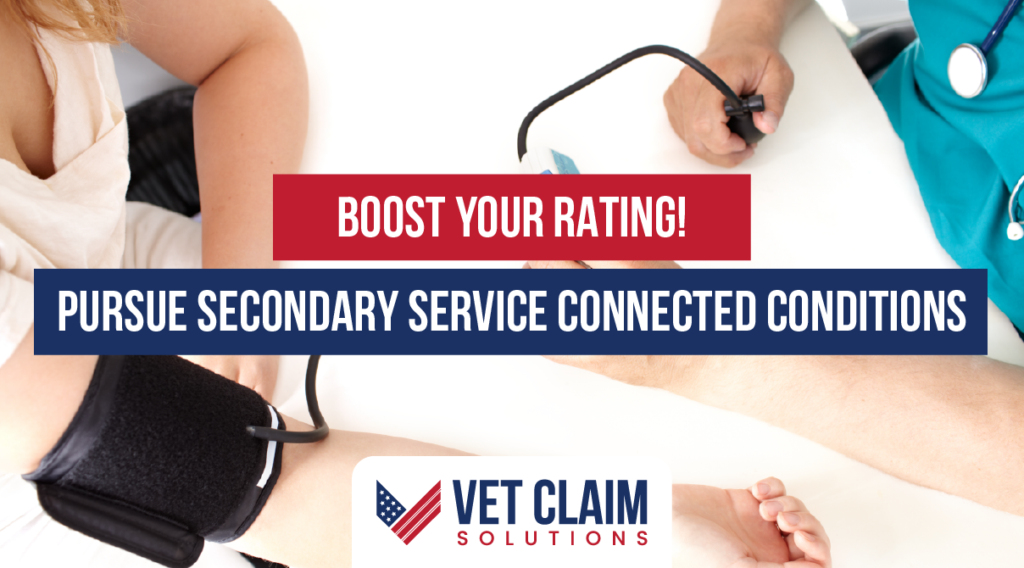If you’re a veteran with service-connected disabilities, you may be eligible to receive additional benefits and compensation through the pursuit of secondary service-connected conditions. Secondary service-connected conditions are related to an existing rated disability and can increase your VA rating and compensation. By understanding what constitutes a secondary service-connected condition and how to pursue them, you can maximize the benefits you’re entitled to. This article will provide an overview of secondary service-connected conditions and how they can help boost your VA rating.
What is a secondary service-connected condition?
A secondary service-connected condition is related to an existing disability rating by the VA. These conditions may be caused or simply impacted by a service-connected disability and can increase your VA rating—and in turn, the compensation you receive. Secondary service-connected conditions can also include disabilities that result from treatment for a primary service-connected disability, such as an allergy to a medication used to treat the condition.
Eligibility requirements for a secondary service-connected condition
To be eligible for a secondary service-connected condition, you need to have an existing disability rating by the VA with at least a 0% rating. The severity of the secondary disability must also meet specific criteria by the Department of Veterans Affairs. The veteran must be able to demonstrate that there is a clear medical link between the original service-connected disability and any secondary conditions you’re claiming.
Benefits of Pursuing a Higher Rating for Secondary Service-Connected Conditions
Pursuing a higher rating for secondary service-connected conditions can have numerous benefits. It can help to increase your compensation and allow you to receive more financial assistance from the VA. A higher rating may also provide access to additional services or support you may not have been eligible for. Ultimately, pursuing a higher rating for any secondary service-connected condition can help to ensure that you receive the full range of benefits to that you are entitled.
Types of Secondary Service-Connected Conditions
The types of secondary service-connected conditions that veterans may be able to claim to vary but typically include physical disabilities and mental health issues.replica uhren legal

Physical Disabilities
Physical disabilities include arthritis, chronic pain, degenerative joint diseases, vision problems, hearing loss, and other medical conditions. For example, a veteran has a service connection for his back, and this condition has caused the veteran to develop sciatica problems.

Mental Health Issues
Mental health issues may include post-traumatic stress disorder (PTSD), depression, anxiety, and other mental health conditions. For example, a veteran is a service for many conditions, from orthopedic injuries to tinnitus and migraines. These conditions have caused the veteran to develop a mental health disorder in response to those service-connected conditions.

Other Medical Issues
Other secondary service-connected medical issues include sleep disorders, chronic fatigue syndrome, and fibromyalgia. For example, a veteran is rated for PTSD, sinusitis, and deviated septum. These conditions have caused the veteran to develop or worsen his/her sleep apnea.
Obtaining VA Rating for a Secondary Service-Connected Disability
When filing a claim for secondary service-connected disabilities, it is important to understand that VA has a reputation for denying these types of claims if the connection to the primary service-connected disability is unclear. It is important to provide compelling evidence that establishes a direct correlation between the two disabilities, which will help prove your case.
Medical records and documentation from your doctor, medical consultant, or the latest research can provide invaluable evidence for your claim. It is also important to indicate if the new condition is a direct result of the service-connected disability or aggravated by the service-connected disability. This will help show how the two are connected.
It is also important to remember that even if you provide enough evidence to prove your case, VA still may decide to deny your application for secondary service-connected benefits. This means that the condition will not be rated, and you will not receive compensation for the new disability.
While filing a claim for secondary service-connected disabilities can be difficult, it is important to provide as much evidence as possible to help support your claim and make it easier for VA to approve. With the right evidence and a compelling case, you may be able to receive the rating and compensation you deserve.

How to File a Secondary Service-Connected disability claim
If you’ve suffered a service-connected injury or disability and want additional compensation for any secondary conditions, filing a secondary service connection claim is an option. When submitting the claim, it is important that you are clearly articulate to the VA that the new condition you are applying for is secondary to the designated service condition you are tying it to.
Failure to annotate this correctly may cause the VA to look at this new condition as direct service, which could negatively impact its chances of getting approved for service connection.
To submit the secondary claim, here are the steps to take:

1. Collect Relevant Documentation
The first step in claiming a secondary service-connected condition is to collect all relevant medical documentation. This includes any records from the initial service-connected disability and records documenting the development of any subsequent disabilities or conditions.

2. Seek a Nexus Letter or Medical Opinion
Once you have your documents, you should seek a nexus letter from a medical provider with the credentials and expertise to argue the medical connection between your service-connected condition and the new secondary condition you are applying for. The nexus letter should reference scientific studies that show the relationship between the two conditions.
In addition, the nexus letter may also utilize case law and reference previous VA decisions that have already approved the relationship between the requested secondary and service-connected condition(s).

3. Submit Your Claim
Once you have collected all of the evidence related to the secondary condition, it is time to submit your claim to the VA using the Application for Disability Compensation and Related Compensation Benefits, VA Form 21-526EZ.
This application can be completed online, by fax, mail, or even in person at your VA Regional Office.

4. Prepare for the Compensation and Pension (C&P) Exam
Once the claim is received by the VA, they may request a C&P exam to evaluate the conditions submitted with the new claim. It is most likely that VA will examine both the secondary condition being pursued and the existing service-connected conditions it is being tied to. C&P exams are completed by a VA medical provider, typically a doctor, physician assistant, nurse practitioner, or psychologist. The provider may be an employee of the VA or contracted to them.
The veteran must clearly understand how the secondary condition and the existing service-connected are tied together and can articulate that to the VA provider during the exam. The veteran should know what evidence was submitted for the claim and be able to speak on those documents and how they support the premise of the claim.

5. Wait for the Decision from the VA
After the C&P exam, the VA will move forward with deciding on your claim. It’s important to remember that processing can take some time and not to expect an immediate response from the VA. Once the claim has been decided, you will receive an official decision letter from the VA with the results if the claim was approved or not and the reasoning behind the Decision.
Conclusion:
The VA provides veterans with the opportunity to claim secondary service connections, which can help to ensure that they are receiving the full range of VA disability benefits that they deserve, such as increased compensation and access to additional services. However, to have a successful claim, veterans must provide new and relevant evidence of a link between their existing service-connected disability and any secondary conditions. Following the steps outlined in this article, veterans can pursue a higher rating for secondary service-connected conditions.
If you have conditions that you believe can be tied to your military service using this secondary service-connected approach and would like to receive help filing the claim, don’t hesitate to reach out to Vet Claim Solutions. Our Claims Coaches have years of experience helping hundreds of veterans win claims using this tactic resulting in big increases in their disability ratings. Remember, we offer a free no-obligation consultation call to see if our services would be a good fit for you.

FAQ’s
What is a secondary service connection?
A secondary service connection is when a veteran has an existing service-connected disability and develops subsequent medical conditions related to the original injury or disability. The VA may consider these secondary conditions as service-connected and provide additional compensation.
How do I increase my service-connected disability rating?
Suppose you have an existing service-connected disability and develop a secondary condition related to the original injury or disability. In that case, you may be eligible for an increase in your service-connected disability rating. To do this, you must submit a supplemental claim with new and relevant evidence of a link between your original service-connected disability and any secondary conditions.
You may also need to request an exam from a VA-certified physician and submit the evidence to support your claim. The VA will then decide on your claim, which can take some time. You may be eligible for a higher rating and additional compensation if approved.
How difficult is it to get a 100% VA disability rating?
Getting a 100% VA disability rating can be difficult, and it depends on the severity of your disability. To receive a higher rating, you must provide evidence of the disability that meets the VA’s criteria for a 100% rating. You may also be eligible for TDIU (Total Disability Individual Unemployability).
How long does it take to get your VA disability rating increased?
The amount of time it takes to have your VA disability rating increased depends on the complexity of your claim and the evidence you provide. Generally, it takes the VA several weeks to several months to process claims. However, this timeline can vary depending on the individual situation.
Can I appeal a VA disability rating decision?
Yes, you can appeal a VA disability rating decision. If you disagree with the VA’s Decision on your claim, you can submit an appeal to the Board of Veterans’ Appeals. This process can take several months or even years, depending on the complexity of your case. Additionally, you may need to provide additional evidence or testimony to support your appeal.



This Post Has 3 Comments
Reading your article has greatly helped me, and I agree with you. But I still have some questions. Can you help me? I will pay attention to your answer. thank you.
Your article helped me a lot, is there any more related content? Thanks!
Pingback: Getting a Tendonitis VA Rating: Comprehensive Guide for Vets - VET CLAIM SOLUTIONS